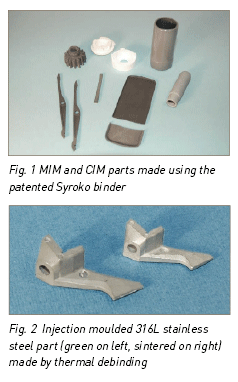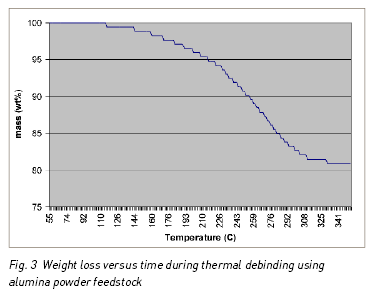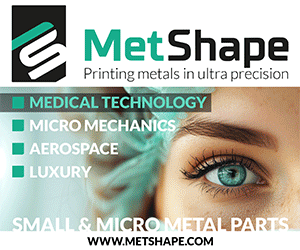Syroko promotes new binder for Powder Injection Moulding
January 29, 2010
Syroko BV, a company newly established in The Netherlands to develop advanced materials, reports that it has successfully adapted its patented binder technology for both the Metal Injection Moulding (MIM) of stainless steel (316L) and the Ceramic Injection Moulding (CIM) of alumina and zirconia powders.
The company states that the successful development of the new binder for PIM followed cooperation with Dutch ceramic injection moulding company Formatec BV, based in Goirle. The new binder is said to be not only environmentally friendly and safe, but also meets several other key requirements identified by Syroko as important to potential customers:
-
Processing has to be carried out using existing equipment for moulding and debinding
-
The flow has to be at least as good as existing feedstock
-
The use of any powder to make feedstock
-
The binder components should be widely available and less costly than existing, commercially available binders
-
Easy demoulding
-
Easy debinding, without warpage damage of PIM products
-
The green parts should allow mechanical processing (grinding, drilling, machining).
Syroko claims that its binder can be removed from moulded parts using existing debinding technology (including catalytic debinding), and also by extraction with water and by simple thermal debinding without the use of chemicals to break down the polymer.
The binder material is said to consist of two components: a low molecular weight (Mw) organic material and a polymer in different combinations, plus some additives such as surfactants which may be present in low concentrations.
Syroko states that during injection moulding, the temperature of the feedstock is such that the low molecular weight component is molten and serves as a solvent for the polymer. In the mould, the feedstock cools and the low Mw component and the polymer phase separate. After cooling, all binder components are solid.
The two binder components are then each removed in successive debinding steps. In the first step the low Mw material is removed. Depending on the choice of this component this can be done by extraction or evaporation which, Syroko states, leaves the polymer part of the binder as a porous material. The porous polymer fixes the geometry of the moulded part and prevents shrinkage or damage of the part, even during complete removal of the low Mw component.
 The porosity that is created in the first debinding step facilitates the removal of gaseous debinding products during the second debinding step, i.e. the removal of the polymer. Depending on the polymer used, the second debinding step can be carried out by thermal or chemical decomposition, such as in the case of catalytic debinding. In several trials Polyoxymethylene (POM or polyacetal) was used, which was removed by catalytic debinding using concentrated nitric acid. However, the catalytic debinding process could also be omitted without any detrimental effect on the quality of the products; POM as a binder polymer has also been removed by thermal decomposition, states Syroko.
The porosity that is created in the first debinding step facilitates the removal of gaseous debinding products during the second debinding step, i.e. the removal of the polymer. Depending on the polymer used, the second debinding step can be carried out by thermal or chemical decomposition, such as in the case of catalytic debinding. In several trials Polyoxymethylene (POM or polyacetal) was used, which was removed by catalytic debinding using concentrated nitric acid. However, the catalytic debinding process could also be omitted without any detrimental effect on the quality of the products; POM as a binder polymer has also been removed by thermal decomposition, states Syroko.
Another characteristic claimed in this new binder concept is that its flow properties can be adjusted within a wide range. In the molten state the binder is a polymer solution instead of a polymer, and the viscosity of the molten binder is determined by the combination of the low Mw component and the polymer used. If necessary, the viscosity can be decreased either by choosing a lower molecular weight grade of the polymer, by increasing the low Mw/polymer ratio, or by a combination of both. The good flow of the binder has made it possible to mould products with a length / thickness ratio of 70.
The PIM alumina and silicon nitride products shown in Fig. 1 were made by extraction of the low Mw component with water followed by catalytic debinding of the second polymer component. The MIM stainless steel (316L) part shown in Fig.2 was produced by debinding of both components in a single time temperature programme, without catalytic debinding, the use of solvents or other methods to decompose the binder. The evaporation of the low Mw component and the pyrolysis of the polymer (in this case POM) were carried out in an oven as one processing step.
 The parts shown in the examples had a thickness not exceeding 4 mm, but it is expected that the porosity generated during debinding leaves room for a further increase of the thickness of the moulded products.
The parts shown in the examples had a thickness not exceeding 4 mm, but it is expected that the porosity generated during debinding leaves room for a further increase of the thickness of the moulded products.
Fig. 3 shows the weight loss versus time for a 17 g alumina sample during thermal debinding. The part was heated in air at a heat-up rate of 1.5 ºC/min in air. The evaporation and depolymerisation of the polymer overlap during the process.
Syroko is seeking to license its binder technology. For more information email: [email protected]

















